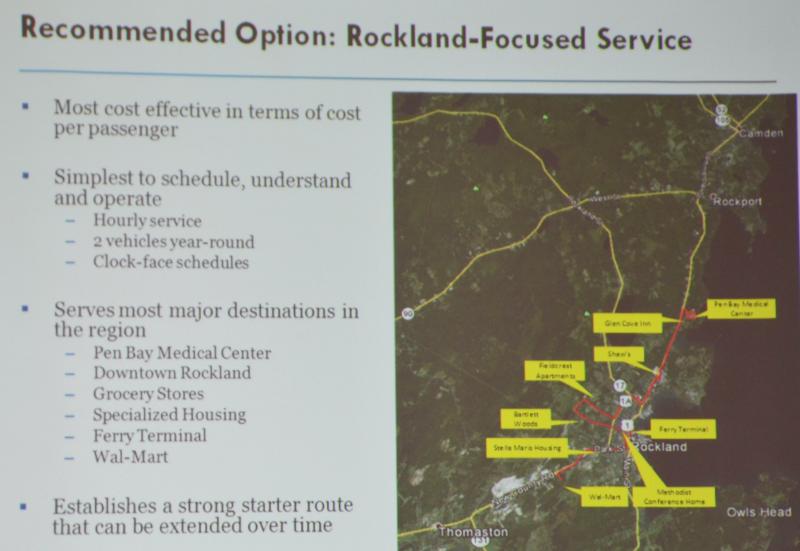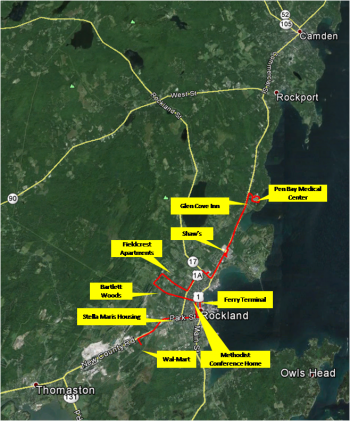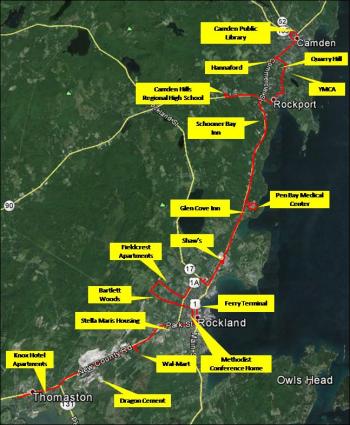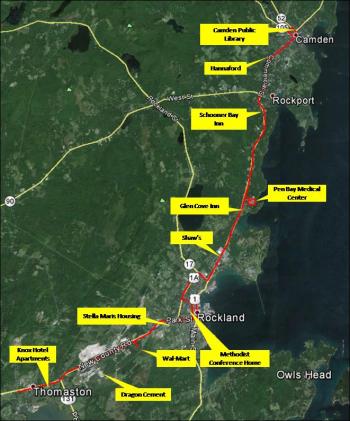ROCKLAND — The jury is in, and transportation consultants are recommending that if the Midcoast wants to proceed with establishing public transit, start with a Rockland-centric approach.
That was the message delivered Tuesday, April 22, at a gathering of the Midcoast Transportation Committee at the Rockport Town Office. There, Project Administrator Boris Palchik, of consulting associates Nelson/Nygaard, outlined the results of a year-long study of a potential Thomaston-to-Camden bus service in various manifestations.
After summing up four scenarios, he said the recommended initial route lies primarily within the Rockland city limits, a simple bus line that would run between Pen Bay Medical Center (just over the line in Rockport) and Walmart, just beyond the city’s southwest end, in Thomaston.
“The service is expected to appeal to Rockland residents and tourists staying in the area, including people on boats and traveling by ferry,” the report said. “Rockland has the highest transit need and transit potential in the study area based on its demographic and land use characteristics. This option is designed to appeal to a broad range of market segments, but in a limited geographic area. It is also designed to allow for incremental expansion if a phased approach is taken to the implementation of comprehensive corridor-wide service.”
"The Midcoast Transit Committee will meet in the next couple of weeks and discuss the report, the four options and the next steps,” said transit committee Chairman Don White, of Camden. “The committee will also discuss expanding the committee to involve more interested parties and stakeholders. An option that will be addressed is making a next step an implementation phase, which will involve digesting the Nelson/Nygaard report and working with Maine Department of Transportation and another transit source to create an implementation plan and how to fund and market the future transit service for the Midcoast."
White said at the April 22 meeting, “There is a need for transit, but it’s how we put it together.”
The effort was born in conversation almost three years ago to determine if a public transportation system might work again in the Midcoast.
In the last century, there were trains (electric) and buses that ran along the coast on a regular basis, transporting residents from homes to jobs and stores. In 1932, the Tolman Bus Service began, with runs on the hour between Camden and Thomaston, providing a way for the local population to move about the region. Those services faded away with the rise of the automobile. Now, it is Coastal Transportation, a subsidiary of the nonprofit MCH, that provides nonemergency transportation in this area, for the elderly, those with disabilities, and those with low income around Knox, Lincoln, and Sagadahoc counties. There are also several taxi companies that also provide transportation.
In October 2011, public transit advocate Tim Sullivan and Lee Karker of Coastal Transportation raised the idea of bus service. That meeting also included representatives of Friends of Midcoast Maine, Penquis, Pen Bay Healthcare, Gateway 1, and local politicians. They began meet monthly, and the Midcoast Transit Committee subsequently formed, comprising two delegates from each of the four involved communities, as well as other interested parties.
More than a decade ago, Camden had experimented briefly with a summer bus service that looped from points to the north and south of the town line to the downtown, in an attempt to alleviate downtown parking and traffic pressures. But the experiment failed, and the buses were sold to the Island Explorer on Mount Desert.
Last year, the committee hired Nelson/Nygaard Consulting Associates, Inc., of San Francisco, to conduct a $60,000, 11-month feasibility study of a daily transit system here. The study was funded by Maine Department of Transportation, Coastal Transportation, and local matching contributions of $1,650 each from Camden, Rockport, Rockland and Thomaston.
On April 22, a report (see attached for an excerpt) was delivered to the committee, with Palchik summing up its main ideas in a PowerPoint presentation.
Part of the study involved a survey, which gathered opinions of 700-plus local citizens in all age brackets.
“The data collected gives us the needed information on demographics,” said White, at the April 22 meeting.
According to Palchik, 90 percent of the survey respondents said “the time was right to consider expanding transit service in the region.”
He outlined four proposals:
Camden-Thomaston Comprehensive Service — This 20-mile loop would be the longest, and potentially the costliest, but have the broadest range of appeal to a variety of riders, recreationalists, school students, employees and tourists. The route would take roughly an hour and 20 minutes to travel the length of the corridor during non-summer months, and two hours during summer traffic congestion.
The route would be primarily along Route 1, except for deviations to Camden Hills Regional High School (at bell times and during academic year only); to Pen Bay Medical Center, Walmart and downtown Rockland. The service would travel west of downtown Rockland along Route 1A and deviate west to serve the Fieldcrest Apartments and Bartlett Woods. As it is currently designed, Option 1 would operate for 12 hours per day 6 a.m. to 6 p.m., weekdays only.
The operating costs would be $605,000 annually, and each per-passenger ride would cost approximately $11. The hourly operational cost of buses along this route would be $60 an hour, and three buses would be necessary to operate the service during the winter season and four during summer.
Palchik clarified that the cost associated with each of the proposed routes would reflect the actual costs of transporting an individual, given fuel and overhead costs. The actual fare, he said, would be established by another process, and would be a political decision.
Strengths and Weaknesses
|
Strengths |
Weaknesses |
|
Travels the highest density and most destination-rich corridor in community. Provides service to all four study-area communities. Could be implemented with mid-day “flex” option to provide higher level of service to people with higher needs and off-route travelers. Serves Rockland Ferry Terminal. |
Implementation of a flex route could attract some riders but would also loose others. Long travel time and route deviations mean service will not likely be attractive to most choice riders. Without additional resources, service quality erodes during summer months. Does not service Samoset Resort. |
Camden-Thomaston Limited Stop — This route also would serve the Route 1 corridor, but move more quickly and with fewer stops. It would begin at the Camden Public Library and end at Knox Apartments in Thomaston. Stops would include Shaw’s, Hannaford, Pen Bay Medical Center and Wal Mart, but would not travel through Rockport Village and stop at Quarry Hill or the Penobscot Bay YMCA.
“The faster travel time of this option is likely to appeal to people traveling to work and tourist, but be less attractive to transit-dependent riders,” the report said.
The cost would also be less, at approximately $425,000, with a $11.30 per-rider cost.
The service would largely stay on Route 1, except in downtown Rockland, where the proposed service would travel west of downtown Rockland along Route 1A, but unlike the comprehensive run it would not deviate further west and thus would not serve the Fieldcrest Apartments and Bartlett Woods. As it is current designed, Option 1 would operate for 12 hours per day 6 a.m. to 6 p.m., weekdays only. It would require having two buses on the route.
|
Strengths |
Weaknesses |
|
Follows the fastest, most direct path between communities and thus is most comparable to travel by private automobile. Simple service design is easy to understand and easy to use. Travels the highest density and most destination rich corridor in community. Provides service to all four regional communities. Serves Rockland Ferry Terminal. |
Limited stops mean some riders will need to walker longer distances to get to the route. Accessing the service requires walking to Route 1. Does not service several key destinations, incluiding Camden Hills High School, Samoset resort, Quarry Hill and the YMCA. |
Rockland-Focused Service (Pen Bay Medical Center to Walmart) — This recommended route has a limited geography; however, according to the consultants, it has the best potential for building a strong foundation as a starter service.
“Option 3 is designed to focus service on Rockland and key destinations just outside of downtown Rockland, including the Pen-Bay Medical Center in Rockport and Walmart in Thomaston,” the report said.
The service would operate 6 a .m. to 6 p.m. with annual operating costs of approximately $360,000.
Option 3 is expected to provide roughly 160 trips per weekday. The estimated cost per trip is $9.
The riders consist primarily of Rockland residents and employees working at Route 1 employers, as well as individuals traveling to PenBay Medical Center for employment and office visits; shopper and tourists.
Hourly costs estimated at $60, with two buses in operation.
Strengths and Weaknesses
|
Strengths |
Weaknesses |
|
Potential as a “starter” service for region. Connects areas and destinations with highest demand. Can easily be expanded (to Rockport or Camden) or contracted depending on demand (downtown Rockland to Wal-Mart). Can help alleviate parking demand, especially for people working in downtown Rockland who live too far away to walk. |
Services limited geographic area. Alignment includes deviations that will increase travel times for some riders especially riders traveling from north of Rockland to Wal-Mart.
|
Seasonal Service (Camden to Wal-Mart via Samoset Resort) — Designed to operate between the region’s largest and most densely populated communities, as well as the most tourist oriented areas– Rockland and Camden this seasonal provides direct service to the Samoset Resort, in Rockport, and Walmart.
The is designed to operate seven days per week during the summer months only (Memorial Day and Labor Day), 6 a.m. to 6 p.m.
Operational costs are estimated to be approximately $195,000 per year.
The service would attract those living and working in Camden and Rockland, “especially people who work during the summer months only, such as youths and people working in downtown Camden and downtown Rockland,” the repor said. “The route will also appeal to summer residents visiting Camden, Rockland and Samoset Resort. The service also likely appeals to downtown merchants because it provides an option for employees to get to work without driving and likely alleviates – at least partially – parking demand. The service should also serve transit dependent riders, including older adults, recognizing that the service is recommended as a summer time only service; however, older adults and persons with disabilities are more likely to used fixed-route service when the weather is good. Year round needs for these riders may be met by Coastal Trans.”
Option 4 is estimated to carry approximately 150 people, most of which would be derived from people living in corridor, plus a sizeable number of employees and guests at the Samoset Resort. The estimated cost per trip is $14.40, with three vehicles on the road for 90 days.
Strengths and Weaknesses
|
Strengths |
Weaknesses |
|
Provides a fast and direct link between highest needs communities. Serves three of the four communities in Mid-Coast region. Offers most economic-development potential and opportunities to alleviate parking demand. Could function as “starter” service to serve time with greatest need and opportunity. |
Limited appeal to transit dependent community, except for youths employed during summer months. |
Documents support the study, providing demographic information and analyses of the Midcoast have been assembled at midcoastplanning.org/transitstudy.html.
Related stories






























